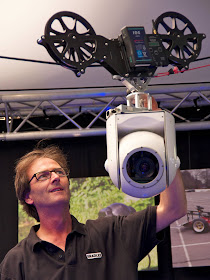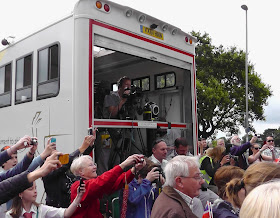Sony has announced two new 4K cameras (the PMW-F5 and
PMW-F55), plus the impending arrival of the 4K upgrade for the NEX-FS700, as it
begins to get serious about moving beyond HD. The new cameras will use a new
codec: XAVC. All the cameras use single Super35-sized CMOS sensors.
Sony started its move into 4K (4096x2160 pixels) with the
F65 last year, and now has a range of 4K-capable equipment, including domestic
and professional LCD and projector displays.
The high-end F65 is well regarded in the film industry, and
the camera has been used on such movies as Oblivion and After Earth.
In fact, the F65 is now going beyond 4K, following its
version 3.0 upgrade it will also be able to shoot 6K and 8K Raw (it uses a full
8K/20-megapixel sensor). It will also be able to shoot at up to 120 frames per
second in 8K. It can be fitted with a new 0.7-inch OLED viewfinder (the first
such for this type of camera), and has received several other film-related
additions, such as anamorphic lens support.
However, as the F65 moves even further upmarket, the F55 and
F5 should slot seamlessly in underneath it.
Open codec architecture
The cameras will support four codecs:
XAVC, for high frame
rates and 4K, MPEG2 at 50Mbps, MPEG4 SStP (Sony’s SR Master codec) and Raw 4K
“by the switch of a button, depending on what job you want to do,” said Olivier
Bovis, Sony’s Head of AV Media.
The F5 and F55 will need the new AXS-R5 recorder for Raw,
but everything else will be recorded internally on a new, faster, memory card:
SxS Pro+, which will support higher frame rates and bit rates – it is about
20/30% faster than an SxS Pro card at writing/reading and comes in 64GB and
128GB versions.
The F55 will be able to simultaneously record both MPEG2
50Mbps and XAVC 4K to the same SxS Pro+ card, which means you can have a
readily usable 50Mbps version for offline editing in a 4K production, or just
hold an archive of 4K shots for the future while shooting for today’s broadcast
standards. You should also be able to record Raw 4K at the same time to the R5
recorder.
Internally, the F55 will be able to record HD (1920x1080),
2K (2048x1080), QFHD (Quad Full HD - 3840x2160), and 4K, while the F5 will be
limited to 2K and HD, but once you add the R5 both will record Raw 4K and
higher frame rates.
The F55 “has a very wide colour gamut [same as the F65] and
high frame rates: up to 180fps in 4K and up to 240fps in HD,” said Bovis. It
also has a Global Shutter to avoid any rolling shutter skew effect or flash
banding. The F5 will shoot at up to 120fps in HD. The F65 can shoot at up to
180fps at 4K and up to 240fps in 2K Raw.
The cameras are promised to offer a wide dynamic range (14
stops), high sensitivity, and low noise.
Viewfinders + monitors
Thanks to a new digital interface, the PMW-F5 and F55 will
also be able to use the new DVF-EL100 1280x720 OLED viewfinder. There is also a
new 3.5-inch 960x540-pixel LCD viewfinder (DVF-L350), offering 10x the contrast
of previous Sony LCD viewfinders plus a flip-up eyepiece for direct monitoring,
and a 7-inch 1920x1080 LCD on-camera monitor (DVF-L700).
The PMW-F55 can also connect to Sony’s
new 4K 30-inch 10-bit LCD
monitor (PVM-X300) for on-set monitoring, dailies and editing using four 3G-SDI
interfaces to monitor pictures at 4096x2160 resolution at up to 60p while
recording and playing back XAVC 4K images. It can also be
connected directly to
the 84-inch BRAVIA 4K LED TV for monitoring, but at a resized horizontal
resolution of 3860 pixels.
Batteries + rigs
The F5 and F55 also use compact new Olivine (Lithium Iron
Phosphate) batteries that promise twice the lifetime of conventional Lithium
Ion cathodes and provide an hour of power for Raw recording when using the R5
with either the F5/F55 (Raw is more power hungry than the other codecs). There
is also a new 2x faster battery charger.
The cameras will also have a new shoulder rig, “so you can
easily use it shoulder mounted. It’s very modular in how you want to use it,”
said Bovis.
PL-mount lenses
The F55 and F5 cameras come with a PL lens mount, for use
with high-end cine-style lenses, but Sony is also launching six new CineAlta
T2.0 PL-mount lenses for the cameras (20, 25, 35, 50, 85 and 135mm).
Each is certified for 4K and is designed to minimize
geometric distortion, vignetting and breathing. A 9-blade iris should deliver
pleasing bokeh (out-of-focus effects), and the focus rings rotate 240°. For
easy lens changes, each has the same external diameter, matte box diameter, and
gear locations for follow focus and aperture. All are the same lenght except
for the 135mm.
The cameras are fitted with a native FZ mount (but the
PL-mount adaptor is supplied), so users will also be able to fit other adaptors
for Canon EF, Canon FD, Nikon DX, Nikon G, Leica M and even 2/3-inch B4 lenses.
Availability
The F5, F55, F65 upgrade, and lenses should be available by
the end of January, but 2K and QFHD recording for the PMW-F55 and 2K for the
PMW-F5 will be available through a firmware upgrade. Frame rates higher than
60fps will also require a firmware upgrade.
Prices should be announced in November.
NEX-FS700 + HXR-1FR5
At its introduction, last April, Sony promised that the
NEX-FS700 would be able to record 4K, and soon it will, using the new HXR-1FR5
interface unit, which has 3G HD-SDI input, to deliver Raw data, and the new
AXS-R5 recording unit – which uses a new generation of Access Memory Card with
512GB of storage. It will also require a firmware upgrade.
Although the FS700 can already record high frame rates in
HD, it won’t have that feature in 4K, where the available frame rates will be
23.98p, 25p, 29.97p, 50p and 59.94p.
The HXR-IFR5 and firmware upgrade should be available
between April and June 2013.
By David Fox

















